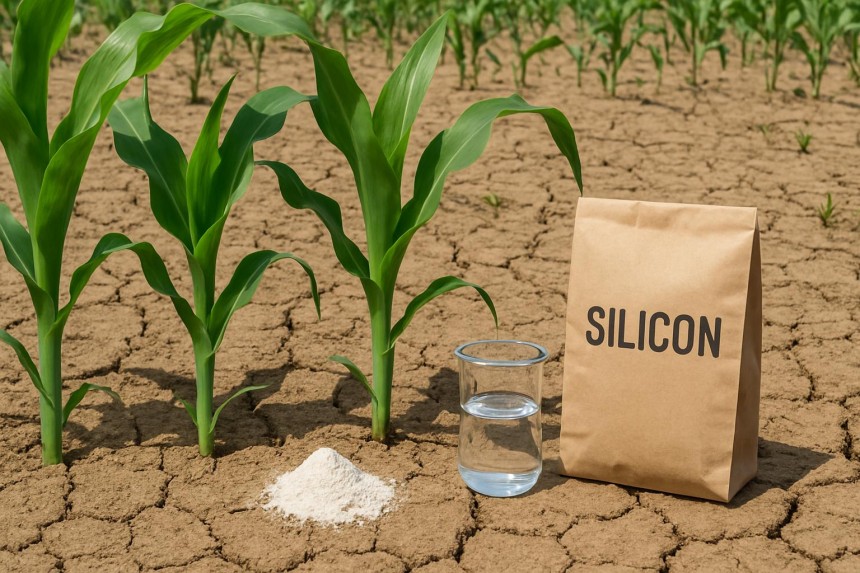
Agricultural Experts Share Insights on Combating Abiotic Stress with Silicon
Learn how silicon is helping farmers and agricultural experts combat abiotic stress like drought, salinity, and heat. Discover its role, applications, and science-backed benefits in crop resilience.
In modern agriculture, abiotic stress is a silent yield killer. While pests and diseases get much of the attention, it’s the non-living stressors—like drought, salinity, heat, cold, and nutrient imbalance—that are consistently wreaking havoc on crops. These invisible challenges account for more than 50% of global crop losses, according to multiple agricultural research institutes. But in the midst of this challenge, a quiet hero is gaining ground: silicon.
Agricultural scientists and subject matter specialists are increasingly acknowledging silicon's transformative effect on crop resilience after it was long disregarded as non-essential. Enhancing plant structure, nutrition intake, and defence systems against a variety of environmental stressors is more important than merely ensuring life.
Abiotic Stress in Crops
The term "abiotic stress" refers to the negative consequences caused by non-living elements. Drought, heatwaves, extreme cold, waterlogging, salinity, heavy metal toxicity, and UV radiation all fall under this umbrella. In addition to weakening crops, these stressors change metabolism, slow growth, lower germination rates, and ultimately lower yields.
Unlike bugs, you can’t apply a pesticide and remedy drought. Therefore, a key component of sustainable agricultural practices is prevention and bolstering the crop's natural defences.
Stressed crops exhibit signs such as diminished fruit setting, nutritional deficiencies, leaf curling, wilting, and discoloration. Abiotic stress frequently impairs nutrition absorption itself, while some farmers try to address these problems with fertilisers. Here's where silicon comes into play.
Silicon’s Role: From Soil Mineral to Stress Fighter
For many plants, silicon is regarded as "beneficial" even though it is not formally recognised as a necessary nutrient. Unlike nitrogen or phosphorus, it doesn't directly support growth, but it does have a defense function that becomes more important in high-stress situations.
Plants absorb silicon, which builds up in their cell walls to create a physical barrier that increases mechanical strength and reduces water loss. Additionally, it enhances the plant's antioxidant activity, helps regulate transpiration, and activates genes associated with stress.
For instance, silicon intake in rice makes the outer layer of leaves stronger, which makes the leaves more erect and less likely to lodge. It promotes root growth and strengthens resilience to temperature fluctuations in sugarcane and wheat.
Silicon treatment increased drought tolerance in maize by up to 35%, according to recent studies published in Frontiers in Plant Science. This improvement was attributed to improved membrane stability and water-use efficiency.
By making plants more resilient and receptive to current nutrients, silicon enhances rather than replaces conventional inputs.
Real-World Insights from the Field
Dr. Anita Mehra, an agronomist based in Maharashtra, has been working with farmers in semi-arid regions for over a decade. Her trials with silicon fertilizers in tomato and brinjal farms showed notable differences during peak summer seasons.
“We saw significant reduction in leaf scorching and a longer shelf life post-harvest,” she said. “It’s not a silver bullet, but it enhances the plant’s ability to cope when conditions turn hostile.”
According to her data, tomato plots treated with silicon sprays saw 18–22% higher yield under heat stress compared to untreated plots.
Silicon can also influence how crops respond to herbicide exposure, especially in no-till and conservation agriculture. Forinstance, in fields where weed control is managed usingGLYFOS 41 - Glyphosate 41% SL Herbicide, some crops can show signs of oxidative stress. In these cases, pre-treatment with silicon foliar sprays has been observed to mitigate some of the phytotoxic symptoms by enhancing antioxidant defenses and cell wall strength, according to local extension officers.
How Silicon Works Differently Under Each Stress
Each type of abiotic stress triggers a different plant response—and silicon helps tailor those defenses in unique ways.
Under Drought Stress
Silicon reduces transpiration by forming a silica cuticle under the epidermis, which limits water loss while maintaining CO₂ exchange. This keeps stomata functioning optimally even under reduced irrigation or low rainfall.
Under Salinity Stress
In saline soils, silicon helps by limiting sodium uptake and enhancing potassium absorption. This restores ionic balance in plant cells, preventing toxicity. It also helps maintain chlorophyll concentration under salt-stressed conditions.
Under Heat and UV Stress
In leaf tissue, silicon builds up, protecting sensitive cells from oxidative damage brought on by high temperatures and radiation. It encourages the synthesis of heat shock proteins, which are molecular barriers that safeguard DNA and enzymes from extremely high temperatures.
“Crops don’t need to be pampered—they need to be prepared. Silicon gives them that edge when the weather turns against you.”
Practical Application: How Farmers Use Silicon
Silicon can be applied in multiple ways—soil amendments, foliar sprays, and fertigation systems. Its effectiveness depends on both crop type and the form in which silicon is applied.
Potassium silicate is frequently applied topically. In soil-based treatments, calcium silicate and sodium silicate are more prevalent. Soluble silicon sources are necessary for hydroponic systems in order to ensure adequate uptake.
The application's timing is important. Early silicon application during the vegetative phase aids in establishing internal resistance prior to the onset of stress. In order to promote healing and boost productivity during stressful situations, some farmers also use it.
Some crops, like legumes, benefit more from external supplementing than others, such as rice, wheat, and sugarcane, which are natural silicon accumulators. According to field data from Punjab, chickpea crops produced noticeably greener, firmer leaves when silicon was applied once every 15 days during hot spells.
Backed by Science, Rooted in Tradition
Silicon-rich soils have long been associated with healthier crops. Regions with volcanic soil, naturally high in silica, have historically yielded stronger, more resilient plants. What’s new is our understanding of how to replicate those benefits in silicon-deficient soils.
Studies fromFAO and CIMMYTshow that integrating silicon with existing nutrient management plans can reduce total fertilizer input by 10–15% while maintaining or even increasing yields.
This doesn’t just help crops—it helps the planet. Reduced reliance on chemical fertilizers means lower emissions, less runoff, and better long-term soil health.
Challenges and Misconceptions
Silicon usage isn't as prevalent as it should be, despite its demonstrated advantages. Lack of awareness is the main cause. It is still not considered necessary by many farmers. Others don't know the right product type, dosage, or time.
Additionally, silicon is thought of as a luxury material that is more appropriate for commercial farms than smallholders. There is no truth to this at all. In actuality, because their fields are under more stress and have fewer alternatives for recovery, farmers with limited resources frequently gain more from silicon.
The quality of the products is another issue. Not all fertilisers made of silicon are made equally. Some are poorly bioavailable or have low solubility. It's critical to adhere to suggested application techniques and select goods with demonstrated uptake efficiency.
FAQs
- Is silicon a fertilizer or a supplement?
- Silicon is technically a supplement. It doesn’t directly feed the plant but enhances its ability to use nutrients and resist stress.
- Can I use silicon with other fertilizers and pesticides?
- Yes. Silicon is compatible with most fertilizers and can be mixed with many foliar sprays. However, always conduct a jar test first to avoid any chemical reaction.
- Is it safe for organic farming?
- Many silicon sources like potassium silicate are OMRI-approved for organic use. Just ensure the product label confirms its organic status.
- Will silicon help every crop?
- Crops differ in their ability to absorb and utilize silicon. Grasses and cereals benefit the most, but many fruit and vegetable crops also show improved resistance under stress.
- How often should I apply silicon?
- It depends on the crop and stress conditions. Generally, foliar sprays every 10–15 days during peak stress periods are effective.
Next Step: Fortify, Don’t Just Feed
Resilience is essential in today's farming environment, which is characterised by unpredictable climate conditions, growing input costs, and declining profit margins. It is essential.
Fertilisers aid in the growth of your crops. Their survival is aided by silicon. Reinforcing your current processes is more important than replacing them. Consider silicon to be your plants' stress insurance policy. Your crops need silicon to stay afloat when dryness strikes, the sun burns, or salts seep up from drained soils.
And as we keep looking for high-yielding plants, more intelligent irrigation, and improved weather forecasting, we shouldn't ignore a tool that we already have: our soil.
This Article is written to accelerate businesses. JOIN The Community Now! Fuel your business success with Grow Media Digital! 🚀 Tailoring expert strategies, from SEO to social media, ensure a perfect fit for your needs. With an innovative approach, they stay ahead of trends, guaranteeing measurable growth. Visit growmedia.digitalto bring your business to new heights.





